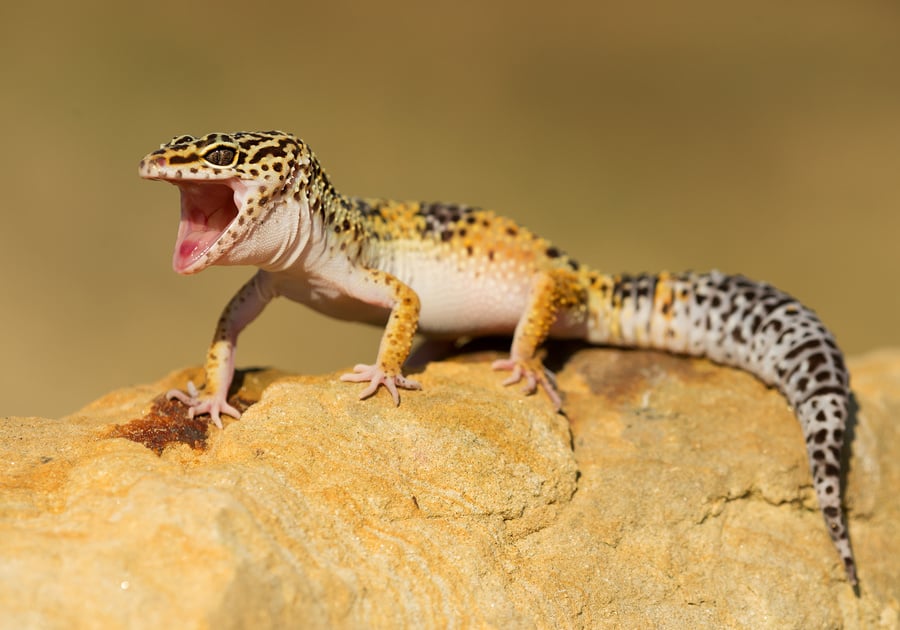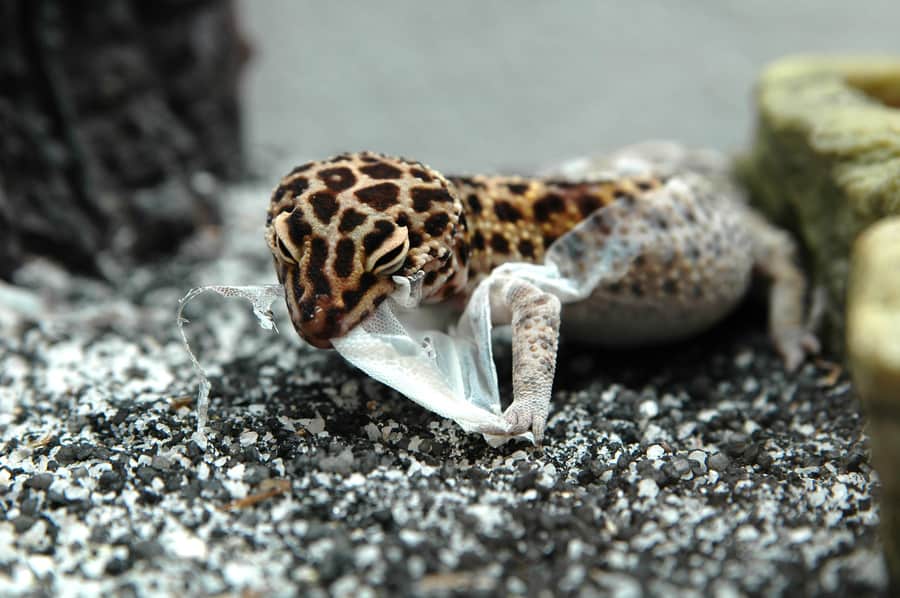In this article, we will explore the intricacies of leopard gecko social interactions, their unique behavior patterns, and how they communicate with their surroundings and humans.
Key Takeaways:
- Leopard geckos are solitary animals by nature and typically do best when kept alone.
- While they may not exhibit complex social structures, leopard geckos can be socialized with proper care and handling to tolerate and even enjoy human contact.
- It is important to provide a safe and comfortable environment for leopard geckos to thrive.
- Leopard geckos have a territorial nature and tend to live alone in the wild, only coming together during the mating season.

The Solitary Nature of Leopard Geckos
Leopard geckos are naturally solitary animals, preferring to live alone rather than in groups. In the wild, they only come together briefly during the mating season, and even then, their interactions are minimal. This solitary nature is reflected in their behavior, as leopard geckos have a territorial instinct and will defend their territory and resources from others.
When kept in the same enclosure, aggressive behavior can occur, leading to potential harm or even death. It is therefore recommended to house leopard geckos individually to ensure their well-being and avoid conflicts.
Leopard Gecko Social Behavior
Leopard geckos exhibit distinct social behavior, characterized by their preference for solitude. They do not form complex social structures like some other lizard species, and their interactions with conspecifics are limited.
Their solitary nature is primarily driven by their territorial behavior, as leopard geckos establish and defend their territories against intruders. This territoriality ensures their access to resources and reduces competition within their environment.
Bonding with Leopard Geckos
While leopard geckos may not be social animals, they can still form bonds with their owners through proper care and handling. By providing a safe and comfortable environment, along with regular interactions, leopard geckos can become accustomed to human presence and even enjoy human contact.
Bonding with a leopard gecko requires patience and consistency, allowing them to feel secure and trust their human companions. Building this bond can result in a rewarding relationship, as leopard geckos may exhibit signs of recognition and familiarity towards their owners.
| Leopard Gecko Social Behavior | Leopard Gecko Territorial Behavior | Leopard Gecko Bonding |
|---|---|---|
| Leopard geckos are naturally solitary animals. | They establish territories and defend them from intruders. | Bonding requires patience and consistency. |
| They do not form complex social structures. | Territorial behavior helps reduce competition for resources. | Proper care and handling can lead to a bond with owners. |
| Their interactions with conspecifics are limited. | They prefer to live alone to avoid conflicts. | Building trust and providing a safe environment is key. |
For a complete breakdown of leopard gecko social behavior, check out this guide. Read this article to learn about leopard gecko mating behavior.
Socializing Leopard Geckos with Humans
While leopard geckos are not social animals by nature, they can be socialized to interact with humans. This process requires proper care, patience, and consistent handling. By following these guidelines, leopard geckos can become comfortable with human contact and even develop a bond with their owners.
Creating Trust and Comfort
Establishing trust is crucial when socializing leopard geckos. Start by providing a calm and safe environment for the gecko. Avoid sudden movements or loud noises that can startle them. Begin with short handling sessions, gradually increasing the duration as the gecko becomes more comfortable.
When picking up a leopard gecko, support its body, making sure not to squeeze or apply excessive pressure. Let the gecko explore your hand at its own pace. Avoid restraining or forcing the gecko to interact if it shows signs of stress, such as hissing or tail rattling. Respect their boundaries and give them time to adjust to the interaction.
Bonding and Interaction
Bonding with a leopard gecko takes time and effort. Interact with your gecko regularly, offering treats or feeding them by hand. This can help create a positive association with human presence. Slowly introduce different types of touch, such as gently stroking their back or chin. Observe their body language and adjust the interaction accordingly.
Remember that each gecko has its own personality, and some may be more receptive to socialization than others. Be patient and understanding, allowing the gecko to set the pace. With consistent and positive interactions, leopard geckos can become comfortable with human contact and enjoy spending time with their owners.
| Tips for Socializing Leopard Geckos |
|---|
| Provide a calm and safe environment |
| Start with short handling sessions and gradually increase duration |
| Support the gecko’s body when picking it up |
| Avoid restraining or forcing interaction |
| Offer treats or hand-feed the gecko to create a positive association |
| Observe and respond to the gecko’s body language |
| Be patient and understanding, respecting the gecko’s boundaries |
Keeping Multiple Leopard Geckos
When it comes to keeping multiple leopard geckos, it is generally best to avoid it. Leopard geckos are solitary animals by nature and prefer to live alone. Introducing multiple geckos into the same enclosure can lead to stress, aggression, and even serious harm. Leopard geckos are known to exhibit territorial behavior and can become aggressive towards each other when their space is invaded.
Leopard geckos may engage in fighting behaviors when housed together, resulting in injuries such as bites and loss of tails. In extreme cases, fights can even lead to one gecko killing another. To ensure the safety and well-being of your leopard geckos, it is recommended to house them separately.
If you are interested in breeding leopard geckos, it is important to research proper breeding techniques and provide individual enclosures for each gecko involved. Breeding should be approached with caution and knowledge to minimize the risk of aggression and harm.
| Reasons to Avoid Keeping Multiple Leopard Geckos | Recommendations |
|---|---|
| Stress and anxiety for the geckos | House leopard geckos individually to ensure their well-being |
| Aggression and fighting | Avoid potential harm by not housing them together |
| Potential injuries and loss of tails | Prevent injuries by keeping them in separate enclosures |
| Risk of one gecko killing another | Ensure the safety of your geckos by not housing them together |
Leopard Geckos and Other Lizard Species
When considering the social interactions of leopard geckos, it is essential to understand their behavior and communication not only with each other but also with other lizard species. While leopard geckos are primarily solitary animals, they may come into contact with other lizards in captive environments or outdoor enclosures. However, it is crucial to approach these interactions with caution and consideration for the unique needs and behaviors of each species involved.
Leopard geckos, with their solitary nature, may exhibit territorial behavior when introduced to other lizard species. Each species has its own set of social dynamics and may not be compatible when housed together. It is vital to research and understand the specific requirements and behaviors of both leopard geckos and the other lizard species before introducing them to the same environment.
Failure to take into account the social interactions and behaviors of different lizard species can lead to stress, harm, or even death for the animals involved. Consulting with experts or experienced reptile keepers can provide valuable guidance and insights regarding the compatibility of different species and how to ensure their well-being when cohabitating.
| Lizard Species | Social Behavior | Compatibility with Leopard Geckos |
|---|---|---|
| Anole Lizards | May display territorial behavior, especially males. | Not recommended to be housed with leopard geckos due to potential aggression and stress. |
| Bearded Dragons | Generally tolerate other bearded dragons but may show dominance or territorial behavior. | Not recommended to be housed with leopard geckos due to potential conflicts and differences in care requirements. |
| Crested Geckos | Can be housed together if provided with adequate space and resources. | Potentially compatible with leopard geckos, but careful monitoring and observation are necessary to ensure the well-being of both species. |
Overall, understanding the social interactions and behaviors of leopard geckos is essential not only for their own well-being but also when considering their interactions with other lizard species. Careful research, observation, and consultation with experts are crucial to create a safe and harmonious environment for all reptiles involved.
Leopard Geckos and Recognizing Their Owners
Leopard geckos, despite their solitary nature, can form a bond with their owners. While the exact mechanisms behind their ability to recognize their owners are not fully understood, there are various theories. Some suggest that leopard geckos may be able to sense vibrations or recognize scent, while others propose that they can detect sound waves. However, it is important to note that there is no conclusive evidence supporting any specific theory.
As owners, we may perceive a bond with our geckos based on their behavior and interactions with us. They may become more comfortable with being handled, showing signs of trust and familiarity. However, it is essential to remember that leopard geckos have a reptilian brain and may not experience emotions or attachments in the same way as mammals. Their behaviors are primarily driven by instinct and survival mechanisms.
Providing a Safe and Comfortable Environment
While the ability of leopard geckos to recognize their owners may be ambiguous, providing a safe and comfortable environment is crucial for their well-being. Ensuring a suitable tank size, maintaining proper temperatures and humidity levels, and offering hiding places are essential factors to consider. It is also important to provide them with a well-balanced diet and access to clean water.
By meeting their basic needs and providing a calm and secure environment, leopard geckos can thrive in captivity. Although they may not form the same emotional bonds as mammals, they can still provide enjoyment and companionship to their owners.
| Benefits of a Safe Environment | Benefits of a Comfortable Environment |
|---|---|
| Promotes overall well-beingReduces stress and anxietyEncourages natural behaviorsImproves appetite and digestion | Enhances gecko’s comfortSupports thermoregulationReduces risk of injuriesEncourages activity and exploration |
Handling Leopard Geckos
When it comes to handling leopard geckos, it’s important to approach them with care and respect their boundaries. While these reptiles are generally docile, they may bite if they feel threatened or cornered. To minimize the risk of being bitten, it’s essential to make slow and confident movements when interacting with your gecko.
Avoid sudden or jerky motions that could startle or stress the gecko. Instead, use gentle and deliberate movements while handling them. This will help establish trust and make the gecko feel more comfortable with human contact. Additionally, it’s crucial to support their body properly when picking them up. Gently scoop them up from underneath, supporting their weight with your hands.
Creating a calm and secure environment is also important during handling sessions. Find a quiet and warm area free from distractions. Providing a safe and comfortable space will help your leopard gecko feel at ease during handling. Remember, every gecko is unique, and some may take longer to become comfortable with handling than others. Be patient and allow them to adjust at their own pace.
Safety Tips for Handling Leopard Geckos
- Wash your hands before and after handling your gecko to prevent the transfer of bacteria or oils.
- Always supervise children when handling leopard geckos to ensure gentle and appropriate interactions.
- Keep handling sessions short initially and gradually increase the duration as your gecko becomes more comfortable.
- Avoid handling your gecko during shedding or when they are visibly stressed.
- Never squeeze or hold your gecko too tightly, as this can cause injury or distress.
Table: Handling Dos and Don’ts for Leopard Geckos
| Do | Don’t |
|---|---|
| Approach your gecko with slow and confident movements. | Make sudden or jerky motions that could startle your gecko. |
| Support your gecko’s body properly when picking them up. | Grab your gecko by the tail or limbs. |
| Create a calm and secure environment for handling sessions. | Handle your gecko in a crowded or noisy area. |
| Wash your hands before and after handling your gecko. | Handle your gecko if they are visibly stressed or shedding. |
Creating a Healthy Environment for Leopard Geckos
Creating a healthy environment is crucial for the overall well-being of leopard geckos. By providing a suitable tank size, regulating temperature and humidity, and offering hiding places, you can ensure that your gecko feels safe and secure. Leopard geckos are ectothermic, meaning they rely on external heat sources to regulate their body temperature. It is important to provide a temperature gradient within their enclosure, with a warm side and a cooler side, allowing them to thermoregulate as needed.
In terms of tank size, a 20-gallon tank is generally recommended for a single adult leopard gecko. This allows them enough space to explore and exercise. It is essential to avoid overcrowding, as cramped conditions can lead to stress and aggression. Additionally, leopard geckos need places to hide and feel secure. You can provide multiple hiding spots using various types of hides, such as rock caves, hollow logs, or commercial leopard gecko hides available in pet stores.

Leopard Gecko Habitat Requirements:
- Tank size: 20-gallon tank for a single leopard gecko
- Temperature gradient: Provide a warm side (around 88-90°F) and a cooler side (around 75-80°F)
- Humidity: Maintain a humidity level between 30-40%
- Substrate: Use a non-adhesive substrate, such as reptile carpet or paper towels
- Hiding spots: Provide multiple hiding places using rock caves, hollow logs, or commercial leopard gecko hides
- Lighting: Leopard geckos are crepuscular and do not require UVB lighting, but they do need a light and dark cycle to maintain their natural behavior
Proper nutrition is also essential for the health of leopard geckos. Their diet mainly consists of live insects, such as crickets, mealworms, and dubia roaches. It is important to provide a varied and balanced diet, supplemented with calcium and vitamin D3 to prevent nutritional deficiencies and metabolic bone disease. Fresh water should always be available in a shallow dish that is easy for the gecko to access.
| Leopard Gecko Diet: | Supplements: |
|---|---|
| Live insects: crickets, mealworms, dubia roaches | Calcium powder: dust insects with calcium powder before feeding |
| Occasional treats: waxworms, superworms | Vitamin D3 supplement: provide once or twice a month |
Regular cleaning of the tank is necessary to maintain a hygienic environment for your leopard gecko. Spot clean the tank daily by removing any uneaten food, feces, or shed skin. A thorough cleaning of the tank, including removing all substrate and disinfecting the enclosure, should be done on a monthly basis. Avoid using harsh chemicals for cleaning, as they can be toxic to your gecko. Instead, opt for reptile-safe cleansers or a mixture of water and mild soap.
Conclusion
Leopard geckos are fascinating creatures with unique behaviors and communication methods. While they are primarily solitary animals, it is possible to socialize them to tolerate human contact. By providing proper care and handling, leopard geckos can form a bond with their owners and become comfortable with interaction.
It’s important to understand that leopard geckos do not exhibit complex social structures or form attachments like mammals. However, they can still recognize their owners based on their interactions and behavior. While the exact mechanisms behind this recognition are not fully understood, it’s important to approach handling sessions with care and respect their boundaries.
To ensure the well-being of leopard geckos and promote their natural behaviors, it is crucial to create a suitable environment. This includes providing a proper tank size, regulating temperature and humidity, offering hiding places, and ensuring proper nutrition and hygiene. By meeting their basic needs and providing a safe and secure environment, leopard geckos can thrive in captivity and live longer, healthier lives.
FAQ
Can leopard geckos live together?
No, leopard geckos are solitary animals and do best when kept alone. They can exhibit aggressive behavior when housed together, leading to potential harm or even death.
Can leopard geckos bond with their owners?
Yes, with proper care, handling, and patience, leopard geckos can form a bond with their owners and become comfortable with human interaction.
What is important for creating a healthy leopard gecko environment?
Providing a suitable tank size, regulating temperature and humidity, offering hiding places, proper nutrition, regular cleaning, and water availability are essential factors for creating a healthy environment for leopard geckos.
